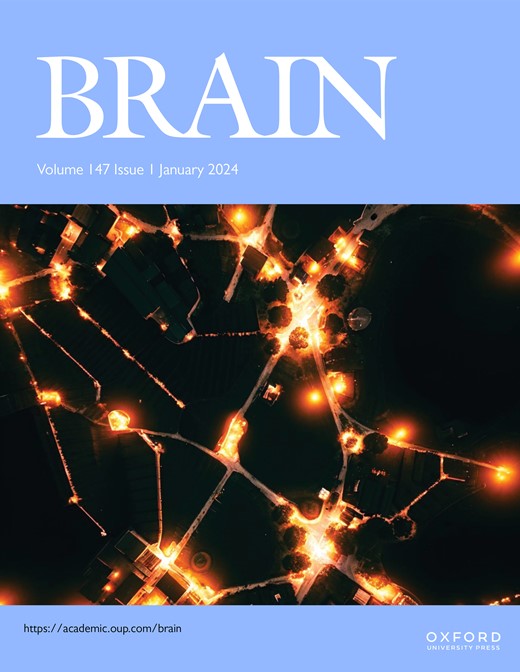Delineating three distinct spatiotemporal patterns of brain atrophy in Parkinson’s disease
IF 10.6
1区 医学
Q1 CLINICAL NEUROLOGY
引用次数: 0
Abstract
The clinical manifestation of Parkinson’s disease exhibits significant heterogeneity in the prevalence of non-motor symptoms and the rate of progression of motor symptoms, suggesting that Parkinson’s disease can be classified into distinct subtypes. In this study, we aimed to explore this heterogeneity by identifying a set of subtypes with distinct patterns of spatiotemporal trajectories of neurodegeneration. We applied Subtype and Stage Inference (SuStaIn), an unsupervised machine learning algorithm that combined disease progression modelling with clustering methods, to cortical and subcortical neurodegeneration visible on 3 T structural MRI of a large cross-sectional sample of 504 patients and 279 healthy controls. Serial longitudinal data were available for a subset of 178 patients at the 2-year follow-up and for 140 patients at the 4-year follow-up. In a subset of 210 patients, concomitant Alzheimer’s disease pathology was assessed by evaluating amyloid-β concentrations in the CSF or via the amyloid-specific radiotracer 18F-flutemetamol with PET. The SuStaIn analysis revealed three distinct subtypes, each characterized by unique patterns of spatiotemporal evolution of brain atrophy: neocortical, limbic and brainstem. In the neocortical subtype, a reduction in brain volume occurred in the frontal and parietal cortices in the earliest disease stage and progressed across the entire neocortex during the early stage, although with relative sparing of the striatum, pallidum, accumbens area and brainstem. The limbic subtype represented comparative regional vulnerability, which was characterized by early volume loss in the amygdala, accumbens area, striatum and temporal cortex, subsequently spreading to the parietal and frontal cortices across disease stage. The brainstem subtype showed gradual rostral progression from the brainstem extending to the amygdala and hippocampus, followed by the temporal and other cortices. Longitudinal MRI data confirmed that 77.8% of participants at the 2-year follow-up and 84.0% at the 4-year follow-up were assigned to subtypes consistent with estimates from the cross-sectional data. This three-subtype model aligned with empirically proposed subtypes based on age at onset, because the neocortical subtype demonstrated characteristics similar to those found in the old-onset phenotype, including older onset and cognitive decline symptoms (P < 0.05). Moreover, the subtypes correspond to the three categories of the neuropathological consensus criteria for symptomatic patients with Lewy pathology, proposing neocortex-, limbic- and brainstem-predominant patterns as different subgroups of α-synuclein distributions. Among the subtypes, the prevalence of biomarker evidence of amyloid-β pathology was comparable. Upon validation, the subtype model might be applied to individual cases, potentially serving as a biomarker to track disease progression and predict temporal evolution.划分帕金森病患者脑萎缩的三种不同时空模式
帕金森病的临床表现在非运动症状的发生率和运动症状的进展速度方面表现出明显的异质性,这表明帕金森病可分为不同的亚型。在本研究中,我们旨在通过识别一组具有不同神经变性时空轨迹模式的亚型来探索这种异质性。我们对 504 名患者和 279 名健康对照者的大型横断面样本的 3 T 结构磁共振成像上可见的皮层和皮层下神经变性应用了亚型和阶段推断(SuStaIn),这是一种将疾病进展模型与聚类方法相结合的无监督机器学习算法。178名患者中的一个子集获得了2年随访的连续纵向数据,140名患者获得了4年随访的连续纵向数据。在 210 名患者的子集中,通过评估脑脊液中淀粉样蛋白-β的浓度或使用淀粉样蛋白特异性放射性示踪剂 18F-flutemetamol 进行 PET 评估了阿尔茨海默病的并发病理。SuStaIn分析揭示了三种不同的亚型,每种亚型都具有独特的脑萎缩时空演变模式:新皮质亚型、边缘亚型和脑干亚型。在新皮质亚型中,额叶和顶叶皮质的脑容量在疾病的最早阶段出现减少,并在早期阶段扩展到整个新皮质,但纹状体、苍白球、延脑区和脑干相对较少。边缘亚型代表了相对的区域脆弱性,其特征是杏仁核、延脑区、纹状体和颞叶皮质的早期体积损失,随后在整个疾病阶段扩散到顶叶和额叶皮质。脑干亚型表现为从脑干逐渐向喙突发展,延伸至杏仁核和海马,然后是颞叶和其他皮层。纵向核磁共振成像数据证实,77.8%的参与者在两年随访中被归入亚型,84.0%的参与者在四年随访中被归入亚型,这与横断面数据的估计结果一致。这个三亚型模型与根据经验提出的基于发病年龄的亚型一致,因为新皮质亚型表现出与老年发病表型相似的特征,包括发病年龄较大和认知能力下降症状(P < 0.05)。此外,这些亚型与路易氏病理症状患者神经病理学共识标准的三个类别相对应,提出了以新皮质、边缘和脑干为主的模式作为α-突触核蛋白分布的不同亚组。在这些亚型中,淀粉样β病理学生物标志物证据的流行率相当。经验证后,亚型模型可应用于个别病例,有可能成为跟踪疾病进展和预测时间演变的生物标记物。
本文章由计算机程序翻译,如有差异,请以英文原文为准。
求助全文
约1分钟内获得全文
求助全文
来源期刊

Brain
医学-临床神经学
CiteScore
20.30
自引率
4.10%
发文量
458
审稿时长
3-6 weeks
期刊介绍:
Brain, a journal focused on clinical neurology and translational neuroscience, has been publishing landmark papers since 1878. The journal aims to expand its scope by including studies that shed light on disease mechanisms and conducting innovative clinical trials for brain disorders. With a wide range of topics covered, the Editorial Board represents the international readership and diverse coverage of the journal. Accepted articles are promptly posted online, typically within a few weeks of acceptance. As of 2022, Brain holds an impressive impact factor of 14.5, according to the Journal Citation Reports.
 求助内容:
求助内容: 应助结果提醒方式:
应助结果提醒方式:


